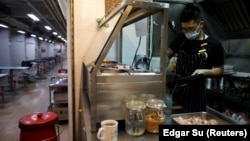Singapore’s tradition of eating out in places called hawker centers is now recognized by the United Nations for its cultural importance.
A hawker is a person who sells food or goods and advertises by shouting at people walking by on the street.
Hawkers are an important part of Singaporean culture. Open-air eating areas where hawkers sell their goods are very popular. Famous chefs, such as Anthony Bourdain and Gordon Ramsay have praised them. And they appear in popular films like ‘Crazy Rich Asians’.
On Wednesday, the United Nations’ cultural agency, UNESCO, added the city’s “hawker culture,” to its Representative List of the Intangible Cultural Heritage of Humanity. Singapore sought to have hawker culture added to the list about two years ago.
Now that it has been recognized, Singapore must provide a report every six years to UNESCO. The report must show efforts the city-state has made to save and support its hawker culture.
“These centers serve as ‘community dining rooms’ where people from diverse backgrounds gather and share the experience of dining over breakfast, lunch and dinner,” UNESCO said.
In the 1970s, Singapore cleaned up its streets so the city moved street hawkers to new eating centers. These areas were part of an effort to improve the island. Now, the centers offer many different low-cost meals for local people and provide a pleasing social setting.
The 2018 film Crazy Rich Asians showed its stars enjoying meals at a famous night market. Some sellers even received Michelin stars from a famous restaurant rating system for their meals costing only a few dollars.
But, Singapore’s hawker culture does face difficulties. The average age of a hawker in Singapore is 60 years old. Younger Singaporeans now want to work in offices. They are less interested in working in small restaurants.
The COVID-19 health crisis also hurt sales, preventing foreign visitors from eating out. During the first few months of this year, restrictions on movement and social distancing also stopped locals.
I'm Armen Kassabian.
Chen Lin at Reuters reported this story. Armen Kassabian adapted it for VOA Learning English. Mario Ritter, Jr. was the editor.
We want to hear from you. Write to us in the Comments Section and visit our Facebook page.
______________________________________________________________
Words in This Story
chef – n. a professional cook who leads a restaurant
intangible – n. not made of physical material, something that cannot be touched but is important
heritage –n. the traditions and beliefs that are part of the history of a group of people
diverse –adj. made up of people or things that are different from each other
dining – n. the process of having a meal















